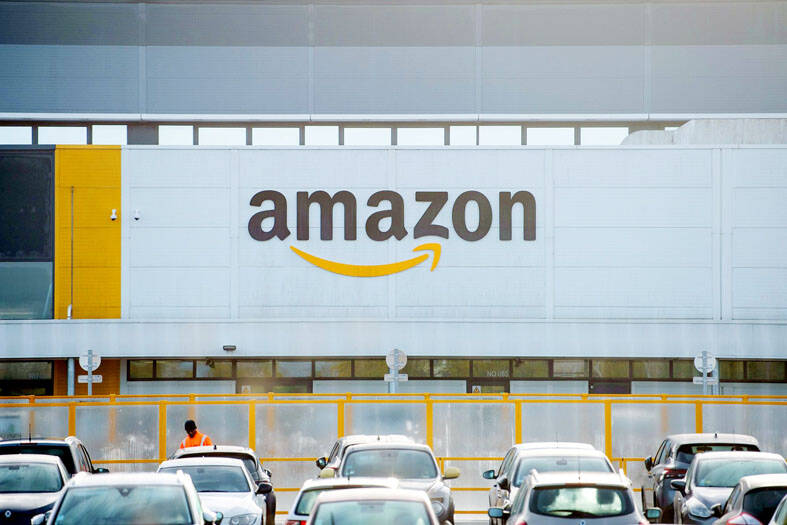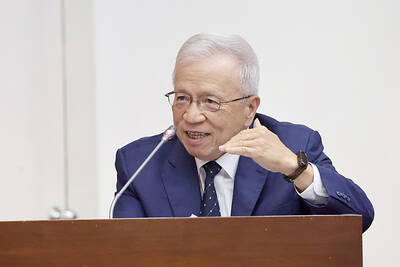Amazon.com Inc is laying off more than 18,000 employees — the biggest corporate workforce reduction in company history — in the latest sign that a tech industry slump is deepening.
Amazon CEO Andy Jassy on Wednesday announced the move in a memo to staff, saying it followed the company’s annual planning process.
The cuts, which began last year, were previously expected to affect about 10,000 people. The reduction is concentrated in the company’s corporate ranks, mostly Amazon’s retail division and human resources functions such as recruiting.

Photo: Bloomberg
“Amazon has weathered uncertain and difficult economies in the past, and we will continue to do so,” Jassy said. “These changes will help us pursue our long-term opportunities with a stronger cost structure.”
Even though the prospect of layoffs has loomed over Amazon for months — the company has said that it hired too many people during the COVID-19 pandemic — the increasing total suggests that the company’s outlook has darkened.
Amazon joins other tech giants in making major cuts.
Earlier on Wednesday, Salesforce Inc announced plans to lay off about 10 percent of its workforce and reduce its real-estate holdings, after the enterprise software company said it hired too many people during a pandemic-fueled boom and is adjusting to more cautious spending by customers.
The workforce moves should be completed by the end of fiscal year 2024, Salesforce, which has about 80,000 employees, said in a regulatory filing.
Amazon’s plan to lay off 18,000 workers would be the biggest cut yet for tech firms during the current slowdown, but the e-commerce giant also has a far bigger workforce than its Silicon Valley peers. It had more than 1.5 million employees as of the end of September last year, meaning the latest cuts would represent about 1 percent of the workforce.
At the time the company was planning its cuts in November, a spokesperson said that Amazon had about 350,000 corporate employees worldwide.
The world’s largest online retailer spent the end of last year adjusting to a sharp slowdown in e-commerce growth as shoppers returned to pre-pandemic habits.
Amazon delayed warehouse openings and halted hiring in its retail group. It broadened the freeze to the company’s staff and then began making cuts.
Jassy has eliminated or curtailed experimental and unprofitable businesses, including teams working on a telehealth service, a delivery robot and a children’s video-calling device, among other projects.
The Seattle-based company also is trying to align excess capacity with cooling demand.
One effort includes trying to sell excess space on its cargo planes, people familiar with the matter said.
Amazon is seeing parts of its business level off, but it continues to invest in its cloud-computing and advertising businesses, as well as video streaming.
In Wednesday’s memo, Jassy said the company would provide severance, transitional health benefits and job placement to affected workers.
He also chided an employee for leaking the news, an apparent reference to a Wall Street Journal report.
The company plans to begin discussing the moves with affected employees on Jan. 18, he said.
“Companies that last a long time go through different phases,” Jassy said. “They’re not in heavy people expansion mode every year.”

JITTERS: Nexperia has a 20 percent market share for chips powering simpler features such as window controls, and changing supply chains could take years European carmakers are looking into ways to scratch components made with parts from China, spooked by deepening geopolitical spats playing out through chipmaker Nexperia BV and Beijing’s export controls on rare earths. To protect operations from trade ructions, several automakers are pushing major suppliers to find permanent alternatives to Chinese semiconductors, people familiar with the matter said. The industry is considering broader changes to its supply chain to adapt to shifting geopolitics, Europe’s main suppliers lobby CLEPA head Matthias Zink said. “We had some indications already — questions like: ‘How can you supply me without this dependency on China?’” Zink, who also

At least US$50 million for the freedom of an Emirati sheikh: That is the king’s ransom paid two weeks ago to militants linked to al-Qaeda who are pushing to topple the Malian government and impose Islamic law. Alongside a crippling fuel blockade, the Group for the Support of Islam and Muslims (JNIM) has made kidnapping wealthy foreigners for a ransom a pillar of its strategy of “economic jihad.” Its goal: Oust the junta, which has struggled to contain Mali’s decade-long insurgency since taking power following back-to-back coups in 2020 and 2021, by scaring away investors and paralyzing the west African country’s economy.

BUST FEARS: While a KMT legislator asked if an AI bubble could affect Taiwan, the DGBAS minister said the sector appears on track to continue growing The local property market has cooled down moderately following a series of credit control measures designed to contain speculation, the central bank said yesterday, while remaining tight-lipped about potential rule relaxations. Lawmakers in a meeting of the legislature’s Finance Committee voiced concerns to central bank officials that the credit control measures have adversely affected the government’s tax income and small and medium-sized property developers, with limited positive effects. Housing prices have been climbing since 2016, even when the central bank imposed its first set of control measures in 2020, Chinese Nationalist Party (KMT) Legislator Lo Ting-wei (羅廷瑋) said. “Since the second half of

Taiwan Semiconductor Manufacturing Co (TSMC, 台積電) received about NT$147 billion (US$4.71 billion) in subsidies from the US, Japanese, German and Chinese governments over the past two years for its global expansion. Financial data compiled by the world’s largest contract chipmaker showed the company secured NT$4.77 billion in subsidies from the governments in the third quarter, bringing the total for the first three quarters of the year to about NT$71.9 billion. Along with the NT$75.16 billion in financial aid TSMC received last year, the chipmaker obtained NT$147 billion in subsidies in almost two years, the data showed. The subsidies received by its subsidiaries —